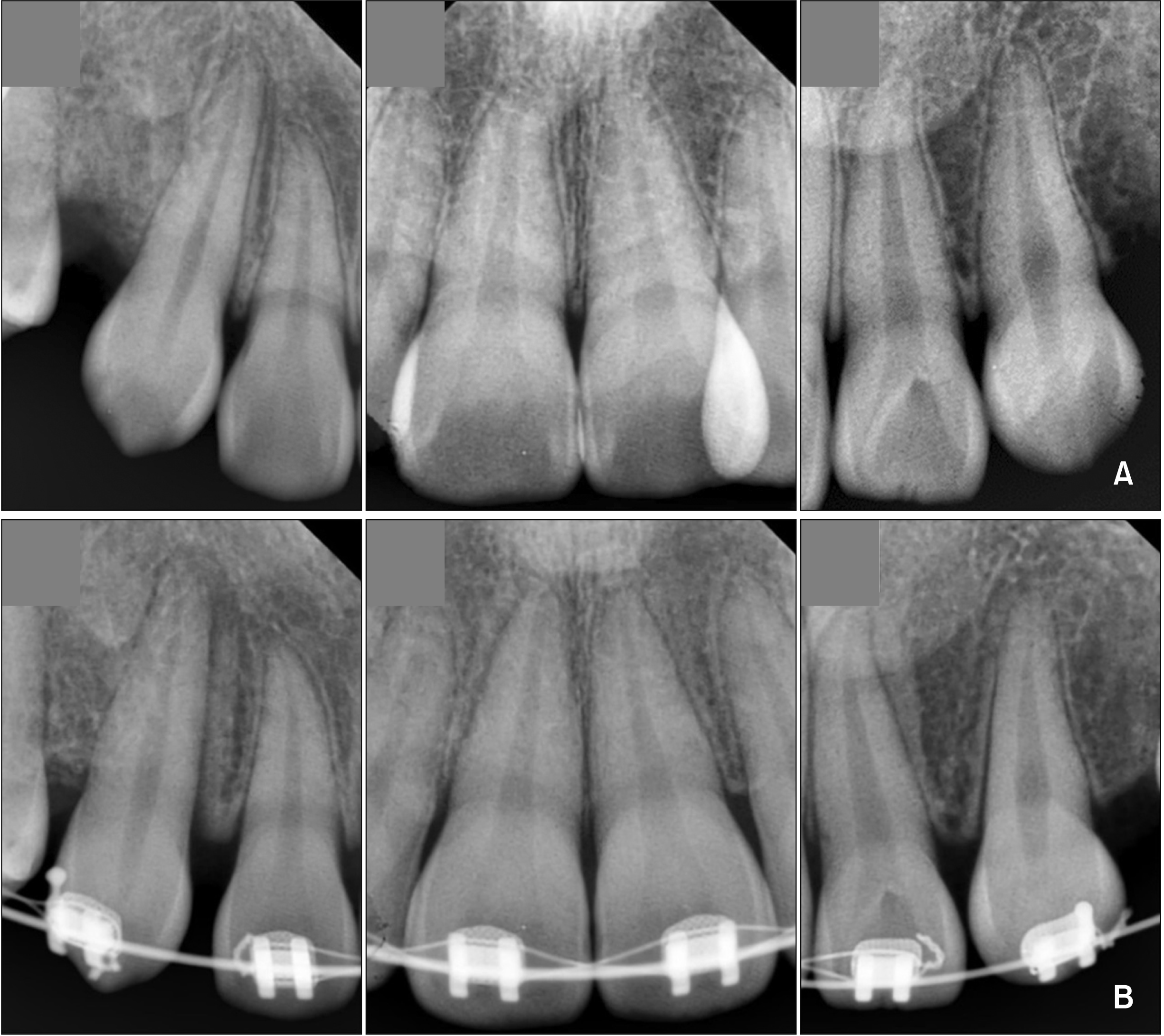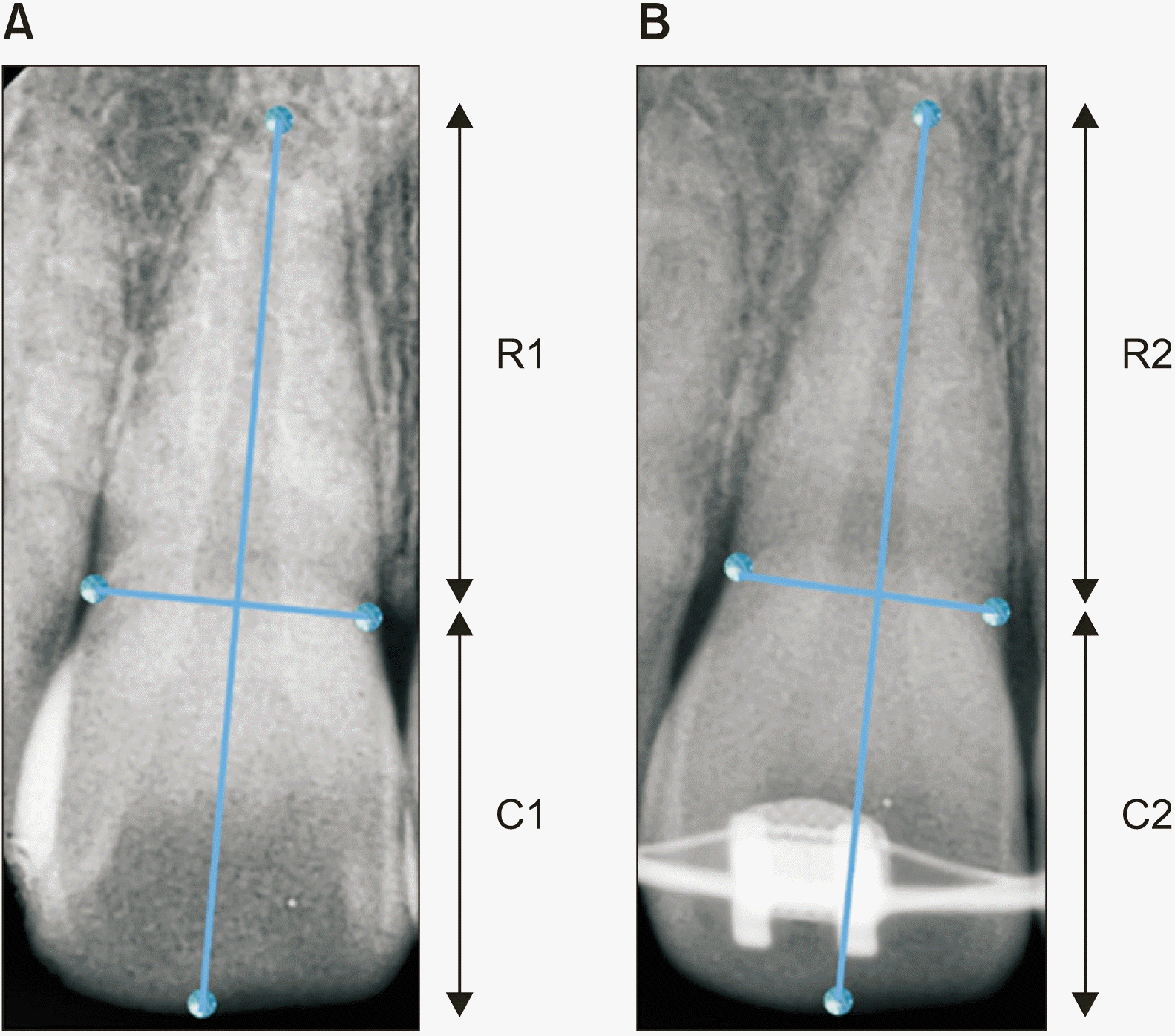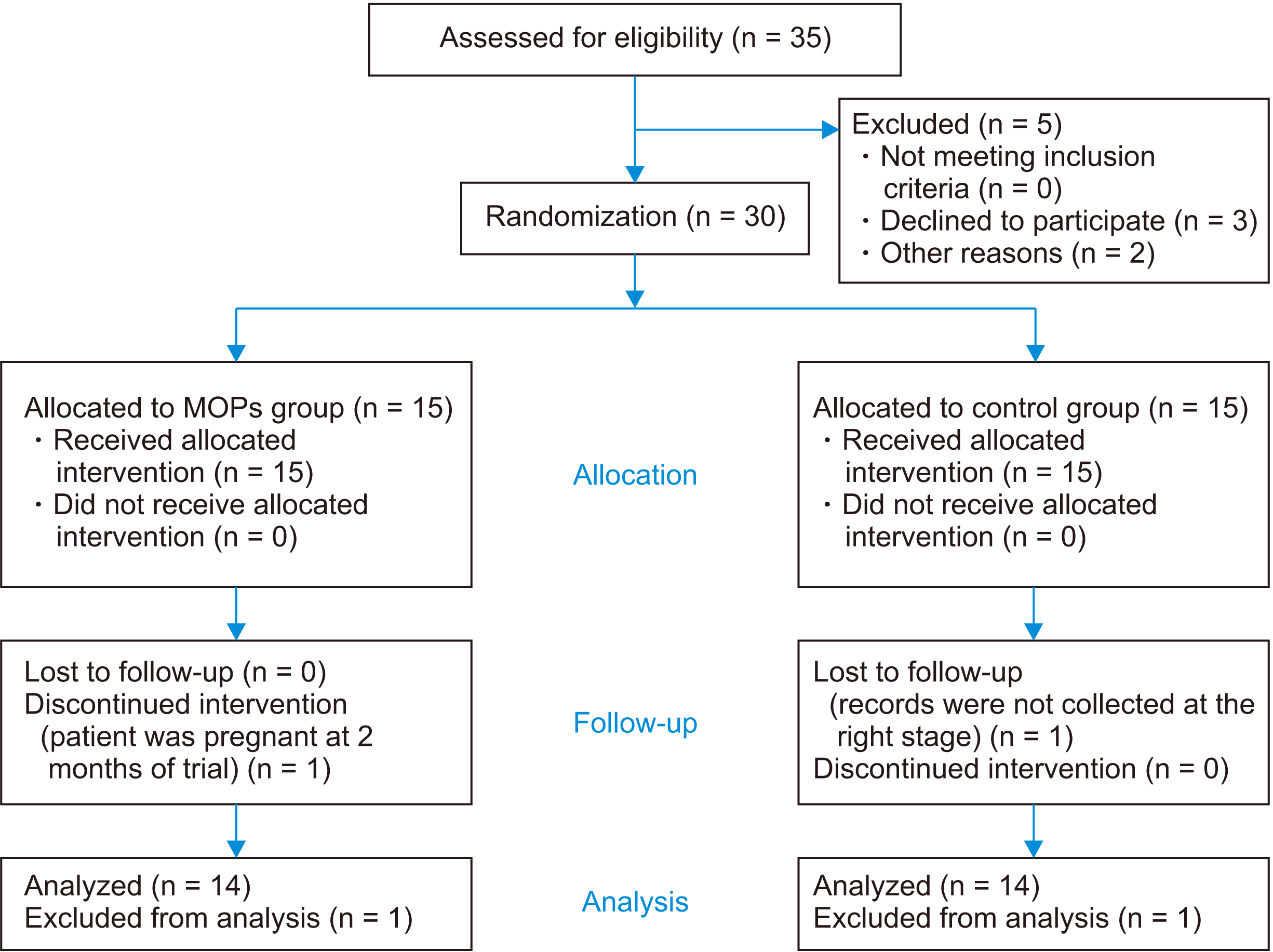2. Fahey T, Stephenson P. 2016; Root resorption during fixed appliance therapy- mechanism, risk factors and prognosis. Orthod Update. 9:96–9. DOI:
10.12968/ortu.2016.9.3.96.
3. Nowrin SA, Jaafar S, Ab Rahman N, Basri R, Alam MK, Shahid F. 2018; Association between genetic polymorphisms and external apical root resorption: a systematic review and meta-analysis. Korean J Orthod. 48:395–404. DOI:
10.4041/kjod.2018.48.6.395. PMID:
30450332. PMCID:
PMC6234115.



4. Roscoe MG, Meira JB, Cattaneo PM. 2015; Association of orthodontic force system and root resorption: a systematic review. Am J Orthod Dentofacial Orthop. 147:610–26. DOI:
10.1016/j.ajodo.2014.12.026. PMID:
25919107.


5. Weiland F. 2003; Constant versus dissipating forces in orthodontics: the effect on initial tooth movement and root resorption. Eur J Orthod. 25:335–42. DOI:
10.1093/ejo/25.4.335. PMID:
12938838.


6. Kalemaj Z, DebernardI CL, Buti J. 2015; Efficacy of surgical and non-surgical interventions on accelerating orthodontic tooth movement: a systematic review. Eur J Oral Implantol. 8:9–24. PMID:
25738176.
7. Al-Naoum F, Hajeer MY, Al-Jundi A. 2014; Does alveolar corticotomy accelerate orthodontic tooth movement when retracting upper canines? A split-mouth design randomized controlled trial. J Oral Maxillofac Surg. 72:1880–9. DOI:
10.1016/j.joms.2014.05.003. PMID:
25128922.


8. Gkantidis N, Mistakidis I, Kouskoura T, Pandis N. 2014; Effectiveness of non-conventional methods for accelerated orthodontic tooth movement: a systematic review and meta-analysis. J Dent. 42:1300–19. DOI:
10.1016/j.jdent.2014.07.013. PMID:
25072362.


9. Abbas NH, Sabet NE, Hassan IT. 2016; Evaluation of corticotomy-facilitated orthodontics and piezocision in rapid canine retraction. Am J Orthod Dentofacial Orthop. 149:473–80. DOI:
10.1016/j.ajodo.2015.09.029. PMID:
27021451.


10. Charavet C, Lecloux G, Jackers N, Maes N, Lambert F. 2019; Patient-reported outcomes measures (PROMs) following a piezocision-assisted versus conventional orthodontic treatments: a randomized controlled trial in adults. Clin Oral Investig. 23:4355–63. DOI:
10.1007/s00784-019-02887-z. PMID:
30955096.


11. Charavet C, Lecloux G, Bruwier A, Rompen E, Maes N, Limme M, et al. 2016; Localized piezoelectric alveolar decortication for orthodontic treatment in adults: a randomized controlled trial. J Dent Res. 95:1003–9. DOI:
10.1177/0022034516645066. PMID:
27129491.


12. Charavet C, Van Hede D, Anania S, Maes N, Lambert F. 2019; Multilevel biological responses following piezocision to accelerate orthodontic tooth movement: a study in rats. J World Fed Orthod. 8:100–6. DOI:
10.1016/j.ejwf.2019.07.002.

13. Charavet C, Lecloux G, Jackers N, Albert A, Lambert F. 2019; Piezocision-assisted orthodontic treatment using CAD/CAM customized orthodontic appliances: a randomized controlled trial in adults. Eur J Orthod. 41:495–501. DOI:
10.1093/ejo/cjy082. PMID:
30649257.


14. Sivarajan S, Ringgingon LP, Fayed MMS, Wey MC. 2020; The effect of micro-osteoperforations on the rate of orthodontic tooth movement: a systematic review and meta-analysis. Am J Orthod Dentofacial Orthop. 157:290–304. DOI:
10.1016/j.ajodo.2019.10.009. PMID:
32115107.


15. Alikhani M, Raptis M, Zoldan B, Sangsuwon C, Lee YB, Alyami B, et al. 2013; Effect of micro-osteoperforations on the rate of tooth movement. Am J Orthod Dentofacial Orthop. 144:639–48. DOI:
10.1016/j.ajodo.2013.06.017. PMID:
24182579.


16. Nanekrungsan K, Patanaporn V, Janhom A, Korwanich N. 2012; External apical root resorption in maxillary incisors in orthodontic patients: associated factors and radiographic evaluation. Imaging Sci Dent. 42:147–54. DOI:
10.5624/isd.2012.42.3.147. PMID:
23071964. PMCID:
PMC3465756.



17. DiBiase AT, Woodhouse NR, Papageorgiou SN, Johnson N, Slipper C, Grant J, et al. 2016; Effect of supplemental vibrational force on orthodontically induced inflammatory root resorption: a multicenter randomized clinical trial. Am J Orthod Dentofacial Orthop. 150:918–27. DOI:
10.1016/j.ajodo.2016.06.025. PMID:
27894540.


18. Levander E, Malmgren O. 1988; Evaluation of the risk of root resorption during orthodontic treatment: a study of upper incisors. Eur J Orthod. 10:30–8. DOI:
10.1093/ejo/10.1.30. PMID:
3162877.


19. Kocadereli I, Yesil TN, Veske PS, Uysal S. 2011; Apical root resorption: a prospective radiographic study of maxillary incisors. Eur J Dent. 5:318–23. DOI:
10.1055/s-0039-1698898. PMID:
21769274. PMCID:
PMC3137446.



20. Smale I, Artun J, Behbehani F, Doppel D, van't Hof M, Kuijpers-Jagtman AM. 2005; Apical root resorption 6 months after initiation of fixed orthodontic appliance therapy. Am J Orthod Dentofacial Orthop. 128:57–67. DOI:
10.1016/j.ajodo.2003.12.030. PMID:
16027626.


21. Alkebsi A, Al-Maaitah E, Al-Shorman H, Abu Alhaija E. 2018; Three-dimensional assessment of the effect of micro-osteoperforations on the rate of tooth movement during canine retraction in adults with Class II malocclusion: a randomized controlled clinical trial. Am J Orthod Dentofacial Orthop. 153:771–85. DOI:
10.1016/j.ajodo.2017.11.026. PMID:
29853235.


22. Aboalnaga AA, Salah Fayed MM, El-Ashmawi NA, Soliman SA. 2019; Effect of micro-osteoperforation on the rate of canine retraction: a split-mouth randomized controlled trial. Prog Orthod. 20:21. DOI:
10.1186/s40510-019-0274-0. PMID:
31155698. PMCID:
PMC6545296.



23. Chan E, Dalci O, Petocz P, Papadopoulou AK, Darendeliler MA. 2018; Physical properties of root cementum: part 26. Effects of micro-osteoperforations on orthodontic root resorption: a microcomputed tomography study. Am J Orthod Dentofacial Orthop. 153:204–13. DOI:
10.1016/j.ajodo.2017.05.036. PMID:
29407497.


24. Motokawa M, Sasamoto T, Kaku M, Kawata T, Matsuda Y, Terao A, et al. 2012; Association between root resorption incident to orthodontic treatment and treatment factors. Eur J Orthod. 34:350–6. DOI:
10.1093/ejo/cjr018. PMID:
21811005.


25. Dudic A, Giannopoulou C, Martinez M, Montet X, Kiliaridis S. 2008; Diagnostic accuracy of digitized periapical radiographs validated against micro-computed tomography scanning in evaluating orthodontically induced apical root resorption. Eur J Oral Sci. 116:467–72. DOI:
10.1111/j.1600-0722.2008.00559.x. PMID:
18821990.


26. Signorelli L, Patcas R, Peltomäki T, Schätzle M. 2016; Radiation dose of cone-beam computed tomography compared to conventional radiographs in orthodontics. J Orofac Orthop. 77:9–15. DOI:
10.1007/s00056-015-0002-4. PMID:
26747662.


27. Janson GR, De Luca Canto G, Martins DR, Henriques JF, De Freitas MR. 2000; A radiographic comparison of apical root resorption after orthodontic treatment with 3 different fixed appliance techniques. Am J Orthod Dentofacial Orthop. 118:262–73. DOI:
10.1067/mod.2000.99136. PMID:
10982926.


28. Levander E, Malmgren O. 2000; Long-term follow-up of maxillary incisors with severe apical root resorption. Eur J Orthod. 22:85–92. DOI:
10.1093/ejo/22.1.85. PMID:
10721249.

29. Sondeijker CFW, Lamberts AA, Beckmann SH, Kuitert RB, van Westing K, Persoon S, et al. 2020; Development of a clinical practice guideline for orthodontically induced external apical root resorption. Eur J Orthod. 42:115–24. DOI:
10.1093/ejo/cjz034. PMID:
31087032. PMCID:
PMC7109605.








 PDF
PDF Citation
Citation Print
Print




 XML Download
XML Download